By Dorothea Shefer-Vanson


MEVASSERET ZION, Israel — The sudden collapse of bookshelves in Yigal’s study, fortunately without injury to life or limb, set in train a course of events (new bookcases in every room) that enabled a thorough sifting-through of books and other items collected in the course of some fifty years.
One of the most interesting objects that came to light was an envelope dating from 1987 containing several pages (typed in Hebrew by Annemarie née Oettinger) describing the events around her arrival in 1935 in the Land of Israel, then Mandatory Palestine. Annemarie was my father’s cousin, and the nine pages describe her subsequent career and life.
Although the Nazis were already in power, she was able to complete her medical studies in Hamburg in 1935 and obtain permission to leave for Palestine on board the S.S.Galilee, known as the Ship of Doctors, because there were over one hundred physicians among its passengers.
There was little work for doctors in pre-State Israel, which was beset by poverty and privation. Unable to find employment in her profession for the first four years after her arrival, Annemarie was obliged to accept all kinds of para-medical jobs, assisting in gathering and analyzing medical statistics, helping midwives and undertaking other volunteer work at Hadassah Hospital in Jerusalem and the Old City, as well as doing other occasional work in Haifa and Tel-Aviv.
Annemarie (who was later known by her Hebrew name, Miriam) finally found work as an independent physician in 1940, attending to the needs of Yemenite immigrants in the tiny village of Pardesiya. The place was no more than a dot on the map, surrounded by desert, whose inhabitants spoke only Arabic and a few words of Hebrew. She spoke German, English, French and a little Hebrew, so that any communication between them had to be conducted in Hebrew. For those immigrants Annemarie served as the sole link with the wider society, to the extent that it was incumbent upon her to go to the rabbi to obtain permission for the immigrants to use birth-control.
Annemarie-Miriam had brought her textbooks and some basic laboratory equipment with her from Germany, and it was on these she relied when it came to solving medical problems. Not only was there no hospital anywhere near, neither was there a paved road, any means of transportation other than a donkey, no public transport, no electricity, running water, radio, newspaper, or any other accoutrement of modern civilization.
For a young woman on her own coming from the modern German metropolis of Hamburg this must have been a culture shock of the most extreme kind. And yet she stuck out that lonely life for two years, with an occasional trip to visit her brother and his family in the Haifa region. Just reading her account of what daily life was like at that time fills one with admiration for the resilience and dedication that she displayed. But considering what was happening in those years in Germany, and afterwards in all of Europe, these hardships were still preferable.
Every now and again Annemarie-Miriam would walk the six kilometers to the nearest place of settlement to read the newspaper and borrow books from the library. That was how she met her future husband, Werner Cohn, whose father was the librarian and who also hailed originally from Germany.
Subsequently Annemarie-Miriam worked for Kupat Holim in various places, once again working primarily with Yemenite and other immigrants in the Hadera region, and retiring in 1986 at the age of 76. Annemarie proudly refers to the couple’s three sons as university graduates in technical subjects who are all employed in good jobs.
By today, thirty years after she wrote her memoir, Annemarie-Miriam is no longer with us, and her three sons have all married and produced children and grandchildren. My own contact with the family is mainly virtual, but from the various social media I know that some of them are involved in promoting social causes and coexistence (among them the Hand-in-Hand schools which were the subject of a previous post), evidently continuing the tradition of social involvement and service to the community displayed by their parents. Like many other descendants of ‘Yekkes,’ their contribution to Israeli society is an admirable credit to their forebears.
*
Shefer-Vanson is an author and freelance writer based in the Jerusalem suburb of Mevasseret Zion. She may be contacted via dorothea.shefer@sdjewishworld.com. Comments intended for publication in the space below MUST be accompanied by the letter writer’s first and last name and by his/ her city and state of residence (city and country for those outside the United States.)